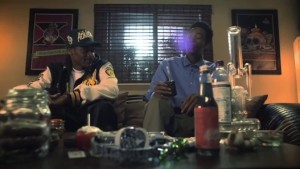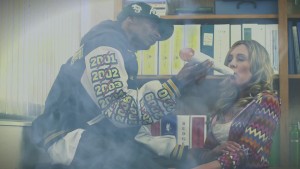“Young, Wild & Free” by Snoop Dogg and Wiz Khalifa paints a picture of a carefree life. The artists encourage audiences to live freely, particularly through the acceptance of illicit substances. The lyrics are quite blunt in this regard– “So what we get drunk? / So what we smoke weed? / We’re just having fun” (“Young, Wild & Free”). To some, this open acceptance about illegal or socially or religiously frowned upon activities is horrifyingly lowbrow. Such themes are commonplace in many popular songs today, though; LMFAO’s “Party Rock Anthem” demands “One more shot for us, another round…Everybody just have a good time / And we gonna make you lose your mind” (“Party Rock Anthem”). These types of lyrics, while common, overflow with references to alcohol and sex; they border on offensive and socially unacceptable. How can such activities be openly discussed, even encouraged?
In Rabelais and His World, Mikhail Bakhtin describes the phenomenon of the carnival. Rooted in the tendency of Middle Age clowns and fools to mimic serious rituals and feudal traditions for the purpose of laughter– often crude and regarding bodily functions and the grotesque– the carnival was a popular lifestyle (Duncombe 83-84). The carefree heart of the Carnival provided an escape from the drags of everyday life; “[the] carnival celebrated temporary liberation from the prevailing truth and from the established order; it marked the suspension of all hierarchical rank, privileges, norms, and prohibitions” (Duncombe 87). In modernity, the truest form of carnival that exists is Mardi Gras– a freeing celebration of rejection of societal standards regarding bodily appearance, behavior, hierarchy and law. Pop culture, however, reflects closely on the same values.

“So what we get drunk?” (Source: https://www.youtube.com/watch?v=kKx9j3KaGAM)
Snoop Dogg and Wiz Khalifa’s “Young, Wild, & Free”, for example, exemplifies a modern carnivalesque, carefree lifestyle as encouraged by Bakhtin. The repeated drug references in the lyrics, as well as the value placed on living without cares, fits the carnival’s disregard for typical societal standards. Bakhtin describes, “During carnival time life is subject only to its laws, that is, the laws of its own freedom… [it was] the second life of the people, who for a time entered the utopian realm of community, freedom, equality, and abundance” (Duncombe 87). Essentially, the carnival has its own laws separate from those of real life, which provides a second, more free and welcoming, world. Some lyrics in “Young, Wild, & Free” openly encourage the breaking of real laws through use of drugs and alcohol. Although some may find these references offensive, religiously sinful, or wrong, “Young, Wild, & Free” relishes any opportunity for escaping social boundaries and living freely.
“Young, Wild, & Free” is part of the Mac and Devin Go to High School movie soundtrack, a film described in its iTunes preview as the “ultimate stoner comedy with a star-studded hip-hop soundtrack” (“Mac and Devin Go to High School”). In the music video, Snoop Dogg and Wiz Khalifa parody the structure of high school as they wreak havoc during a day trip to the teenage years. The music video shows students “Mac” and “Devin” (Wiz and Snoop) fittingly passing their first day at N. Hale High “N. Hale”-ing, as well as their drug trips; the hallways are twisted once each as snow-dusted, an underwater ocean scene, and a cartoon bird haven. Mac and Devin also complete a project for “science class” in which they prepare their own drugs and experiment with THC. Furthermore, throughout the whole video, there is only one appearance of an authority figure, in a screaming adult male, but he does not return again. The carnival rejects all things official and conventional; Mac and Devin certainly achieve a carnivalesque level of freedom in the music video of “Young, Wild, & Free” as they lead the student body in a wild day at school and prevail over authority.

Mac and Devin’s “science project”. (Source: https://www.videogram.com/comic_embed/2997c0f0-87f4-4fcb-9dcd-42cde0276998)
Bakhtin furthers his description of the carnival, “Carnival is not a spectacle seen by the people; they live in it, and everyone participates because its very idea embraces all the people” (Duncombe 86). In order for a carnival to completely reject all forms of hierarchy and structure, it is vital that all types of people participate (Karimova 48, 38). The carnival celebrates the community, and therefore must be inclusive. “Young, Wild, & Free” exemplifies this trait in the featuring of many types of students– the preppy female, the nerd, the athlete, the fat boy in a wheelchair– and shows them all embracing the carnival at school in unison. “The carnivalesque is in brief a celebration of… community; it liberates people and brings them together and induces them to participate in communal living” (Bell 105).

Album Cover of “Young, Wild, & Free” (Source: https://www.youtube.com/watch?v=KEddeCFhExA)
The music video for “Young, Wild, & Free” shows all types of students taking part in the fun as an entire, inclusive student body, rather than as divided by homogenous or exclusive social boundaries. Snoop Dogg lights a huge joint for a preppy white female, and an obese boy in a wheelchair expertly puffs smoke rings. The all-out party at the end of the music video also displays great diversity in the crowd. The point of including all people is also displayed on the album cover; Snoop Dogg is dressed athletically in a varsity jacket, while Wiz Khalifa appears nerdy in a button down. Despite the stigmas regarding these types of students, all of them partake in the festivities and in letting loose and ignoring school authority.

Snoop Dogg shares the love in the “Young, Wild & Free” music video. (Source: http://veehd.com/video/4731201_Snoop-Dog-And-Wiz-Khalifa-ft-Bruno-Mars-Young-Wild-And-Free-mp4)
The wide reach of the “Young, Wild, & Free” lifestyle is also apparent in the background of the song. Wiz Khalifa and Snoop Dogg are both African American, while featured artist Bruno Mars is from Hawaii; the “Smeezingtons” group that composed the song consists of an African-American, a Caucasian, and Hawaiian Bruno Mars. The artists also reject typical lifestyles; Snoop Dogg (formerly Calvin Broadus) was in and out of jail for drug use for several years, and yet has grown into an incredibly successful musician. Neither Snoop nor Wiz Khalifa (formerly Cameron Thomaz) attended college or are married. Both openly attest to cannabis use. Wiz and Snoop both live atypically of societal standards in these ways; encouraging audiences to live in a carnivalesque fashion requires not just telling, but also showing.
“Young, Wild, & Free” is also able to directly influence real life because it helps dancers let loose– the song is no stranger to dance parties. The chorus is catchy, simple, and fun, so when it comes on the speakers, many a dance floor erupt with passionate singing and unembarrassed dancing. Dancing provides easy means to let go of social boundaries, and therefore everyday access to Bakhtin’s carnival; its role is in “inciting the participants to ‘the greatest exaltation of their symbolic faculties’ into play, and triggering ‘the whole pantomime of dancing, forcing every member into rhythmic movement’” (Stam 89). When everyone on a dance floor partakes unabashedly in dancing together, they are bringing the carnival to real life. “The carnivalesque is not restrained to popular culture texts, but transcends to ‘everyday’ life encompassing… those of audiences” (Karimova 37). “Young, Wild, & Free” provides an easy trigger to an unrestricted dance party– a modern carnival.

(Source: https://www.youtube.com/watch?v=9E8_f7ek84c)
A truly inclusive environment, furthermore, is hard to come by in modern society. There are always limiting factors to the extent of a shared experience; money is a frequent concern. A dance floor, however, is one experience that transcends economy. Although the song does encourage certain endeavors that may not be available to all classes, the experience that the song itself provides is. On the other hand, encouraging flashy, crazy parties may seem unwise; however, the benefits of rejecting structure are reaped in the sheer fun to be had. Additionally, although the music video only depicts one school day– a temporary escape– the lesson has been presented (in a readily available song) and viewers must elect to follow in Mac and Devin’s footsteps. The message, furthermore, is widely applicable. Although the song may only be well known to today’s younger generations, the ideals behind it should still be paid attention to by people of all ages. N. Hale High and its liberating wild spirit is a dream come true for students as well as adults bored by the structure and lack of freedom in their lives.
Essentially, Bakhtin’s carnival provides an escape from everyday life via fits of crude humor and unabashed free living, and focuses on welcoming all members of a community despite background, and the rejection of authority, hierarchy, structure, boundaries, and standards (Duncombe 84). Popular culture today, like Snoop Dogg and Wiz Khalifa’s song “Young, Wild, & Free”, strives to achieve these carnivalesque qualities through explicit lyrical content and acceptance of substances typically frowned upon by society, the inclusion of all types of people in the fun, and the deliverance of these qualities to real life. “Carnival changes over time, and if Medieval carnival was a ‘second life’ for people, the contemporary carnival is ‘everyday’ life” (Karimova 46). Ordinary pop culture therefore has become our modern carnival; we must embrace it as an escape from reality and to strive for a “Young, Wild, & Free” lifestyle.
————————-
Works Cited
Bell, Michael Mayerfield, and Michael Gardiner. Bakhtin and the Human Sciences. London: Sage Publications, 1998. Print.
Dogg, Snoop, and Wiz Khalifa. Young, Wild, & Free (feat. Bruno Mars). The Smeezingtons, 2011. Web.
Duncombe, Stephen. “A Politics That Doesn’t Look Like Politics.” Cultural Resistance Reader. London: Verso, 2002. 82-88. Print.
Karimova, Gulnara. “Interpretive Methodology from Literary Criticism: Carnivalesque Analysis of Popular Culture: “Jackass, South Park”, and ‘Everyday’ Culture.” Popular Culture Association in the South 33.1 (2010): 37-51. JSTOR [JSTOR]. Web. 15 Nov. 2016
“Mac and Devin Go to High School.” iTunes Preview. iTunes, n.d. Web. 15 Nov. 2016.
LMFAO. Party Rock Anthem (feat. Lauren Bennett & GoonRock). LMFAO, 2011. Web.
Stam, Robert. Subversive Pleasures: Bakhtin, Cultural Criticism, and Film. Baltimore: Johns Hopkins UP, 1989. Print.